1968 Norton Commando
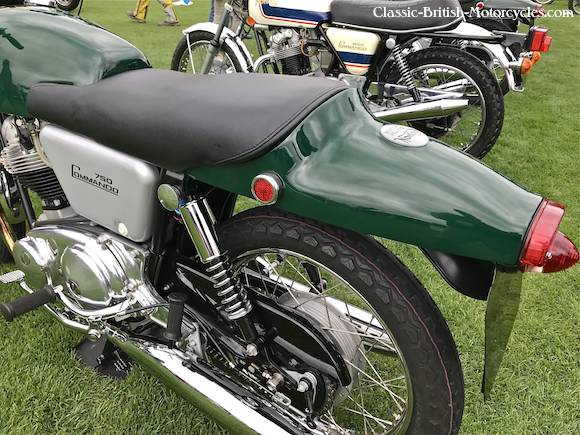
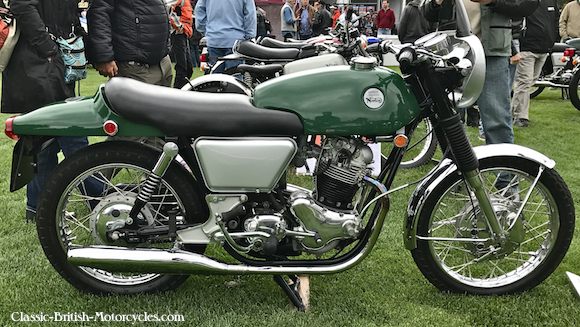
ABOVE: The first 1968 Norton Commando was the Commando Fastback, pictured here in this British racing green, with silver side covers, which is correct for a 1968 Norton Commando.
HOW IT ALL BEGAN
The first Norton Commandos were all Fastbacks, designated Model 20M3, although they weren’t referred to as Commando Fastbacks, just Norton Commandos. The first one, Engine #126125, rolled off the assembly line in February 1968 to rave reviews. The press gushed endlessly about it & sales took off. The Norton Commando literally saved Norton Motorcycles, for a few more years, at least.
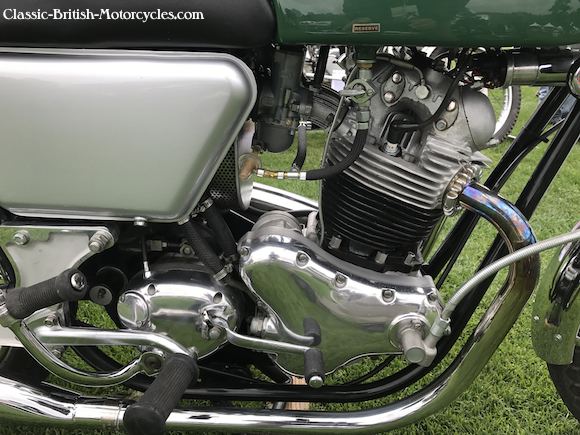
ISOLASTIC SUSPENSION WORKS
Introduced to the world in the 1968 Norton Commando, the Isolastic Suspension System insulated the rider from engine vibration that had plagued the Norton Atlas & Dominator. This allowed the factory to extract more power from the engine, which previously had to be limited in the interest of smoothness. The new setup effectively canceled virtually all mid- & high-rpm vibration. Only at or just above idle (tick over) could any engine vibration be felt, & it was minimal.
1968 NORTON COMMANDO ENGINE SPECS
The engine was the same old 745cc Norton Atlas engine with a 9.0:1 compression ratio & twin 930-series Amal Concentric carburetors. The engine was included forward to give the bike a new look, but this forced the intake manifolds to curve downward to keep the carbs level & clear of the fuel tank. Ignition was by twin coils & a capacitor, powered by a Lucas RM21 alternator inside the primary chaincase. The engine crankcase was a separate component in a textbook example of non-unit construction.
TRANSMISSION
The 4-speed gearbox was straight out of the AMC parts bin with a revised case. The primary chain was triplex. At launch, the very early models came with conventional multiplate wet clutches. But these were soon replaced in production with diaphragm clutches. These did not contain an internal rubber shock absorber like the previous units had. A beautiful outer primary cover was held in place by one central bolt.
ENGINE ASSEMBLY
Every Norton twin before the Commandohad vertical cylinders, like Triumph and BSA. For the all-new Commando, Norton decided to give it a more modern look by mounting the engine at an angle, so that the cylinders now slanted forward at a rakish angle. It really set off the looks of the new 1968 Norton Commando. Accomplishing this was actually easier than it sounds. The engine crankcase, the primary chaincase & the gearbox were all separate units that were bolted together with mounting plates into one solid assembly. Primary chain adjustment was accomplished with an adjustable tensioner rather than by moving the gearbox around in its mounts, like pre-unit Triumph twins. The entire structure incorporated 3 rubber mounts, one at the front of the engine, one at the top of the rocker box & one at the rear above the gearbox. It also provided the mounting for the swingarm pivot. This arrangement allowed the entire engine package & swingarm to move as one in their rubber mounts, insulating vibration from the rest of the chassis & rider. Shims were used to adjust & control sideways movement of the mounts, which could compromise handling.
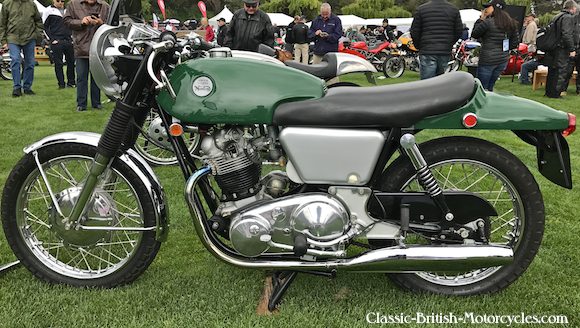
THE NEW FRAME
The frame was conventional with a single large-diameter back bone & twin downtubes forming the engine cradle, then turning up to meet the upper shock mounts, with lots of cross-bracing for strength. However, early frames suffered from weakness around the heastocks & some frames actually broke. This was quickly remedied with the addition of a second backbone tube, running under the main one & further bracing & stiffening the neck.
RUNNING GEAR
The front forks were shortened Roadholder forks, straight from the Norton Atlas parts bin. The front brake was an 8-inch TLS (Twin Leading Shoe) unit in a new full-width, finned alloy hub. This unit was formerly a racing option on later Featherbed Twins. It had a front air scoop & exit vents in back, but the front scoop was blocked off on street bikes. Wheel sizes were 19-inches front & rear with a 3.00 X 19 front tire & 3.50 X 19 rear.
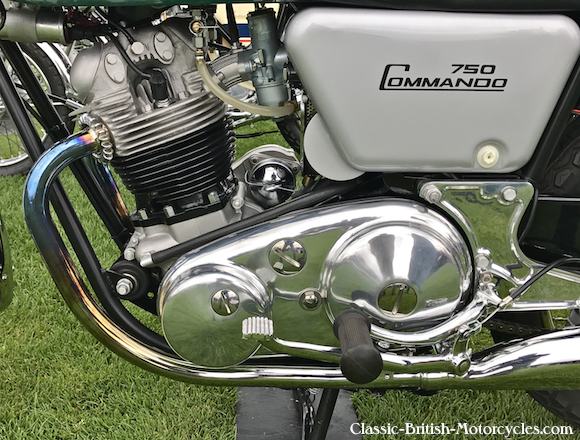
BODYWORK
The tank & tail section were made of fiberglass. The tail section formed the back of the seat & a radical-looking rear fender that gave the bike the nickname “Fastback”, which was soon adopted by the factory when other models of the Commando were introduced & needed to be differentiated from one another. The nose of the dual seat wrapped around the back of the tank forming kneepads. The oil tank was on the right & a matching side over on the left, hiding the battery & electrics. The tool kit was contained in a small compartment in the rear fender that was accessed by removing the seat.
COLORS
The only correct color for a 1968 Norton Commando Fastback was British Racing Green. The tank & tail units were painted as such, with the oil tank & side cover painted silver. The frame & cast iron barrels (cylinder block) were painted black. The tank emblems were a new round Norton logo in green, meant to signify Norton’s emergence into the world market. All it did was confuse buyers & ugly up the bike. Classic Norton script was soon to return.
BELOW: A close up of that famous Fastback-tail.
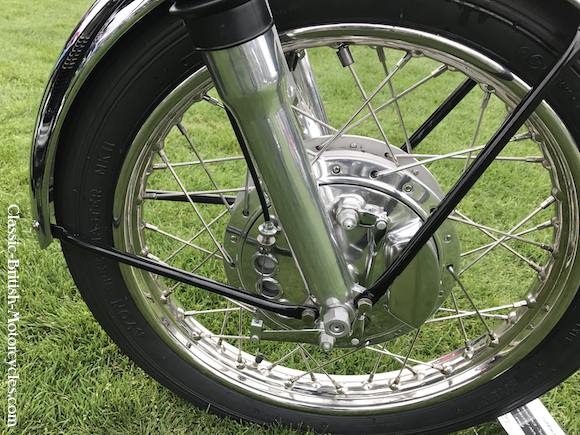
1968 Norton Commando SPECIFICATIONS
|
Model designation Original Price Engine type Displacement Bore & Stroke Compression Carburetors Ignition Engine output Oil system Oil capacity Primary drive Clutch Gearbox Ratios, overall: 1st, bottom 2nd 3rd 4th, top Final drive Frame type Suspension, front Suspension, rear Brake, front Brake, rear Wheelbase Seat height Weight |
20M3 Fastback $1,457.00 Air-cooled OHV parallel twin 746cc / 45 ci 73mm X 89mm / 2.875″ X 3.503″ 9.0:1 2- Amal Concentric, 30mm Battery & coil, Lucas 58 bhp @ 6500 rpm Dry sump 6 pts Triplex chain Multi-plate diaphragm, wet 4-speed constant-mesh, right-foot shift
12.40:1 8.25:1 5.90:1 4.84:1 Chain Welded double cradle, Isolastic Suspension Telescopic fork, hydraulic damping Swing Arm, 2 dampers, Isolastic mounts 8″ TLS drum, full width 7″ SLS drum, full width 57.1″ 31.3″ 431 lbs |


